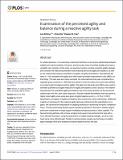Examination of the perceived agility and balance during a reactive agility task
Author(s)
Cain, Stephen M.; Stirling, Leia A.; Eke, Chika Uzoma
Downloadjournal.pone.0198875.pdf (1.319Mb)
PUBLISHER_CC
Publisher with Creative Commons License
Creative Commons Attribution
Terms of use
Metadata
Show full item recordAbstract
This is an open access article distributed under the terms of the Creative Commons Attribution License, which permits unrestricted use, distribution, and reproduction in any medium, provided the original author and source are credited. In vehicle dynamics, it is commonly understood that there is an inverse relationship between stability and maneuverability. However, animal studies have found that stability and maneuverability can coincide. In this study, we examine humans running a reactive agility obstacle and consider the relationship between observational perceived agility and balance, as well as the relationship between quantified surrogates of agility and balance. Recreational athletes (n = 18) completed the agility task while wearing inertial measurement units (IMUs) on their body. The task was also video-recorded. An observational study was completed by a separate group of adults (n = 33) that were asked to view the videos and score each athlete on a Likert scale for balance and for agility. The data from the body-worn IMUs were used to estimate quantified surrogate measures for agility and balance, and to assess if the relationship between the quantified agility and balance was in the same direction as the perceived relationship from the Likert scale responses. Results indicate that athletes that were given a higher Likert agility score were also given a higher balance score (rs= 0.75,p < 0.001). Quantitative surrogates of agility and balance also showed this same relationship. Additional insights on technique for this reactive agility task were informed by the quantitative surrogates. We observed the importance of stepping technique in achieving the faster completion times. The fast performing athletes spent a greater proportion of the task in double support and lower overall time in single support indicating increased periods of static stability. The fast performing athletes did not have a higher body speed, but performed the task with a more efficient technique, using foot placement to enable heading changes, and thus may have had a more efficient path. Similar to animal studies, people use technique to enable agile strategies while also enabling increased balance across the task.
Date issued
2018-06Department
Institute for Medical Engineering and Science; Massachusetts Institute of Technology. Department of Aeronautics and Astronautics; Massachusetts Institute of Technology. Department of Mechanical EngineeringJournal
PLOS ONE
Publisher
Public Library of Science
Citation
Stirling, Leia et al. “Examination of the Perceived Agility and Balance During a Reactive Agility Task.” Edited by Yih-Kuen Jan. PLOS ONE 13, 6 (June 2018): e0198875 © 2018 Stirling et al
Version: Final published version
ISSN
1932-6203